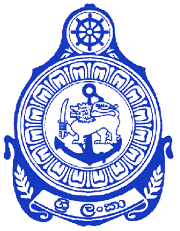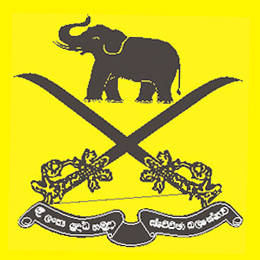Related Research Articles

After the outbreak of the Second World War, in the British Crown Colony of Ceylon, the government of Sir Don Baron Jayatilaka assured the British king and his majesty's government of its continued support.

The Sri Lanka Navy (SLN) is the naval arm of the Sri Lanka Armed Forces and is classed as the country's most vital defence force due to its island geography and is responsible for the maritime defense of the Sri Lankan nation and its interests. The role of the Sri Lanka Navy is to conduct operations at sea for the defence of the nation and its interests and conduct prompt and sustainable combat operations at sea in accordance with the national policies.

The Sri Lankan Armed Forces award medals and their associated ribbon bars in recognition of various levels of service, personal accomplishments and commemorative events while a regular- or volunteer serviceperson is a member of the Sri Lanka Army, Sri Lanka Navy and the Sri Lanka Air Force. Together with military badges, such awards are a means to outwardly display the highlights of a serviceperson's career.

The Sri Lanka Volunteer Naval Force (SLVNF) is the active-duty volunteer reserve force of the Sri Lanka Navy. The SLVNF, which consists of the volunteer force and the volunteer reserve is separate from the Regular Naval Force, which consists of the Regular Force consisting of professional naval officers and sailors, and its Regular Reserve, which comprises personal who have a mobilization obligation following their service in the regular force.

The Sri Lanka Army Volunteer Force (SLAVF) is the active-duty volunteer reserve force of the Sri Lanka Army. The SLAVF is separate from the Regular Force which consists of personal who are professional soldiers and its Regular Reserve, which comprises personal who have a mobilization obligation following their service in the regular army. The SLAVF consists of the volunteer force and the volunteer reserve; administration and recruitment of reserve personal is carried out by the Volunteer Force Headquarters in Shalawa, Kosgama which is headed by the Commandant of the Volunteer Force. It has a current strength of about 55,000 personnel. The SLAVF was known as the Ceylon Volunteer Force from 1949 to 1972 and the Sri Lanka Volunteer Force from 1972 to 1985.

Between 1948 and 1972, Ceylon was an independent country in the Commonwealth of Nations, that shared a monarch with other dominions of the Commonwealth. In 1948, the British Colony of Ceylon was granted independence as Ceylon. In 1972, the country became a republic within the Commonwealth, and its name was changed to Sri Lanka.

Colombo Lighthouse is a Lighthouse in Colombo in Sri Lanka and it is operated and maintained by the Sri Lanka Ports Authority. It is located at Galbokka Point south of the Port of Colombo on the waterfront along the marine drive, in Colombo fort.
Rear Admiral Rajanathan "Rajan" Kadiragamar, MVO was a Ceylonese flag officer. He was the second Ceylonese Captain of the Royal Ceylon Navy from 1960 to 1970 and as such the longest serving Commander of the Navy.

Sir Susantha de Fonseka KBE was a Ceylonese statesmen and diplomat. He was the Deputy Speaker of the State Council of Ceylon and following Ceylon's independence from Britain his first Ambassador to Burma and first Ambassador to Japan. De Fonseka took an active part in the country's struggle for universal suffrage and self-determination.

Vice Admiral A. H. Asoka de Silva, VSV was the Commander of the Sri Lanka Navy from 1983 to 1986. He was the first Sri Lankan Ambassador to Cuba.
Admiral Deshamanya D. Basil Gunasekara was the Commander of the Sri Lanka Navy from 1973 to 1979.
The Trincomalee Garrison is a common name used for collection of military bases of the Sri Lanka Army located in and around the Fort Fredrick and the town of Trincomalee in the Eastern Province. Due to the large natural harbor, it is one of the oldest military garrisons in Sri Lanka and has been occupied by the Portuguese, Dutch, French and the British. Known as Trincomalee Fortress during World War II.
Sri Lanka Navy (SLN) Dockyard is the largest naval base of the Sri Lanka Navy and a major shipyard located in Trincomalee, Sri Lanka. Established by the British as the Royal Naval Dockyard, Trincomalee, it was home to the East Indies Station of the Royal Navy during World War II. Since the withdrawal of the Royal Navy, the Royal Ceylon Navy took over dockyard. It became the home base of the RCyN fleet and today it is home to the Eastern Naval Command and the Naval and Maritime Academy of the Sri Lanka Navy.

Colombo Racecourse is a historical harness racing course in the Cinnamon Gardens, Colombo. During the Second World War, it was used as a temporary airfield. In 2012, it was redeveloped as the Colombo Racecourse Sports Complex to become the first International Rugby Union ground in Sri Lanka to host all the national rugby union side's home matches.
Rear Admiral D. V. Hunter (1917–19??) was Sri Lankan naval officer, who served as the 7th Commander of the Sri Lankan Navy.

Admiral Travis Jeremy Liyanduru Sinniah, WWV, RWP, RSP, USP, ndu, psc was a Sri Lankan admiral and the 21st Commander of the Sri Lanka Navy. He has served as the Commander of Sri Lanka's Eastern Naval Area and as Flag Officer Commanding the Naval Fleet. He was the second Tamil to be appointed the commander of the Sri Lankan Navy after Rajan Kadiragamar in the 1960s.

During the First World War, the Commander-in-Chief at the Cape, Rear Admiral Herbert King-Hall, expended much effort to destroy the elusive German light cruiser Königsberg.
Commander E. P. Wickremasinghe was a Sri Lanka naval officer.
The Ceylon Royal Naval Volunteer Reserve was the volunteer naval reserve of the British Crown colony of Ceylon from 1938 to 1950. Established as the Ceylon Naval Volunteer Force (CNVF) on 1 January 1938 under the Naval Volunteer Ordinance, No, l of 1937. It was made up of volunteers mainly from the mercantile sector of Colombo consisting of 12 officers and 18 sailors, under the command of the newly commissioned Commander W. G. Beauchamp. The first headquarters of the force was set up on 11 January 1939, just before the outbreak of World War II, at Kochchikade.
References
- ↑ "Sri Lanka Navy 1937-1972" (PDF). Sri Lanka Navy. Retrieved 18 May 2022.